Bookshelves have evolved from mere storage solutions to dynamic focal points in contemporary American homes. As we move deeper into 2025, interior designers are shifting away from sterile minimalism toward spaces that radiate personality, warmth, and intentionality. According to weandthecolor.com, sustainability awareness and wellness considerations are dramatically reshaping how homeowners approach decor—especially when it comes to bookshelf styling. Gone are the days of haphazardly stacking books; today’s shelves demand thoughtful curation that balances aesthetics with functionality.
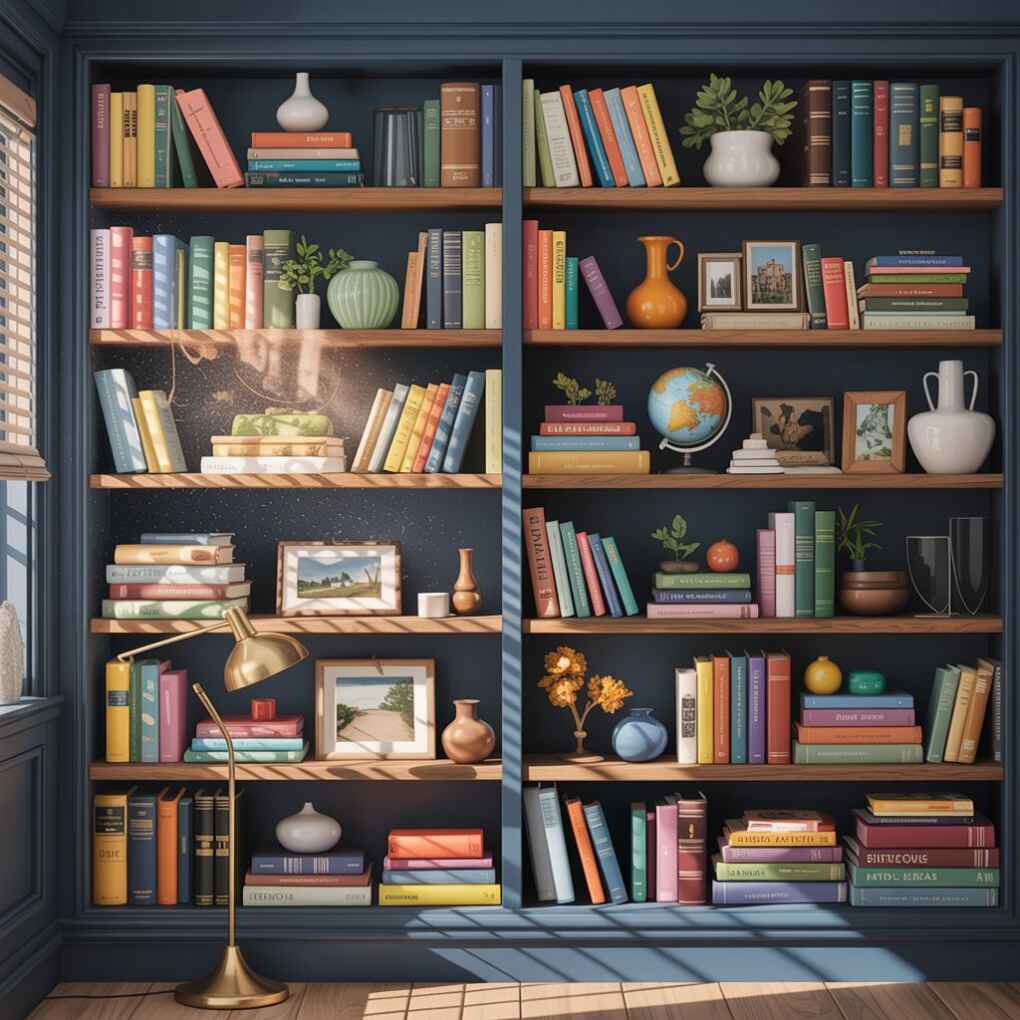
When decorated properly, shelves offer the perfect canvas to showcase your unique identity while elevating your entire room’s aesthetic. livingcozy.com emphasizes that “shelves offer the perfect space to showcase your favorite items and create beautiful arrangements,” making them essential elements in modern living room decor. Whether you’re working with a modest corner unit or an expansive library wall, implementing the right styling techniques transforms ordinary bookshelves into captivating design statements. This guide explores fifteen forward-thinking bookshelf decor ideas specifically curated for American homes in 2025, complete with expert insights to help you avoid common pitfalls while embracing the season’s most exciting trends.
1. The Library Wall Renaissance
The floor-to-ceiling library wall continues dominating 2025 interior design, evolving beyond simple storage into immersive architectural features. Designers are creating entire library experiences where bookshelves cover multiple walls, incorporating integrated seating nooks, reading lamps, and custom ladder systems. This trend moves beyond traditional libraries to transform living rooms and even bedrooms into bibliophile sanctuaries that showcase both functionality and dramatic visual impact.
Rather than treating books as mere props, contemporary designers recommend displaying your actual favorites in curated groupings that tell a story. According to homesandgardens.com, “library wall, floor-to-ceiling bookcases that cover an entire wall of a room (or more)” represent one of the most significant shifts in modern shelving. This approach honors your genuine collection while creating a cohesive, intentional aesthetic that reflects your personality.
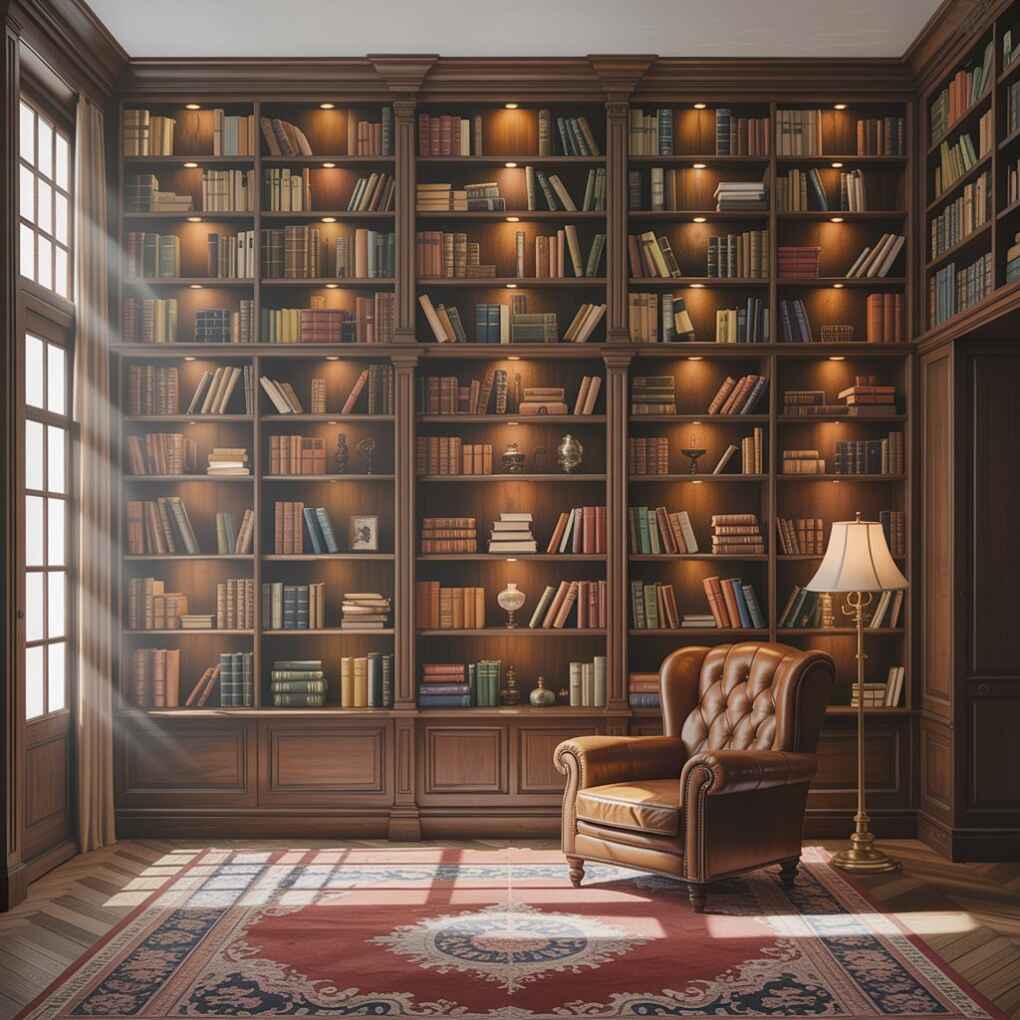
Pro Tip: Create visual interest by mixing open shelving with closed cabinetry sections—display your most beautiful books and objects openly while storing less attractive items behind glass or solid doors.
2. Color-Blocked Collections
Color-blocking book collections by spine creates striking visual rhythm that instantly elevates ordinary shelves. Instead of traditional alphabetical or size-based organization, group books by similar cover colors to form intentional gradients or bold geometric patterns across your shelves. This technique transforms book spines into abstract art pieces that draw the eye and create cohesion throughout your space.
The most sophisticated implementations balance saturated jewel tones with earthy neutrals for visual harmony. As wellness becomes increasingly central to home design, weandthecolor.com notes that “lush jewel tones” are particularly prominent in 2025 interiors. Experiment with deep emerald greens, sapphire blues, and ruby reds against warm beige or parchment backgrounds for maximum impact.
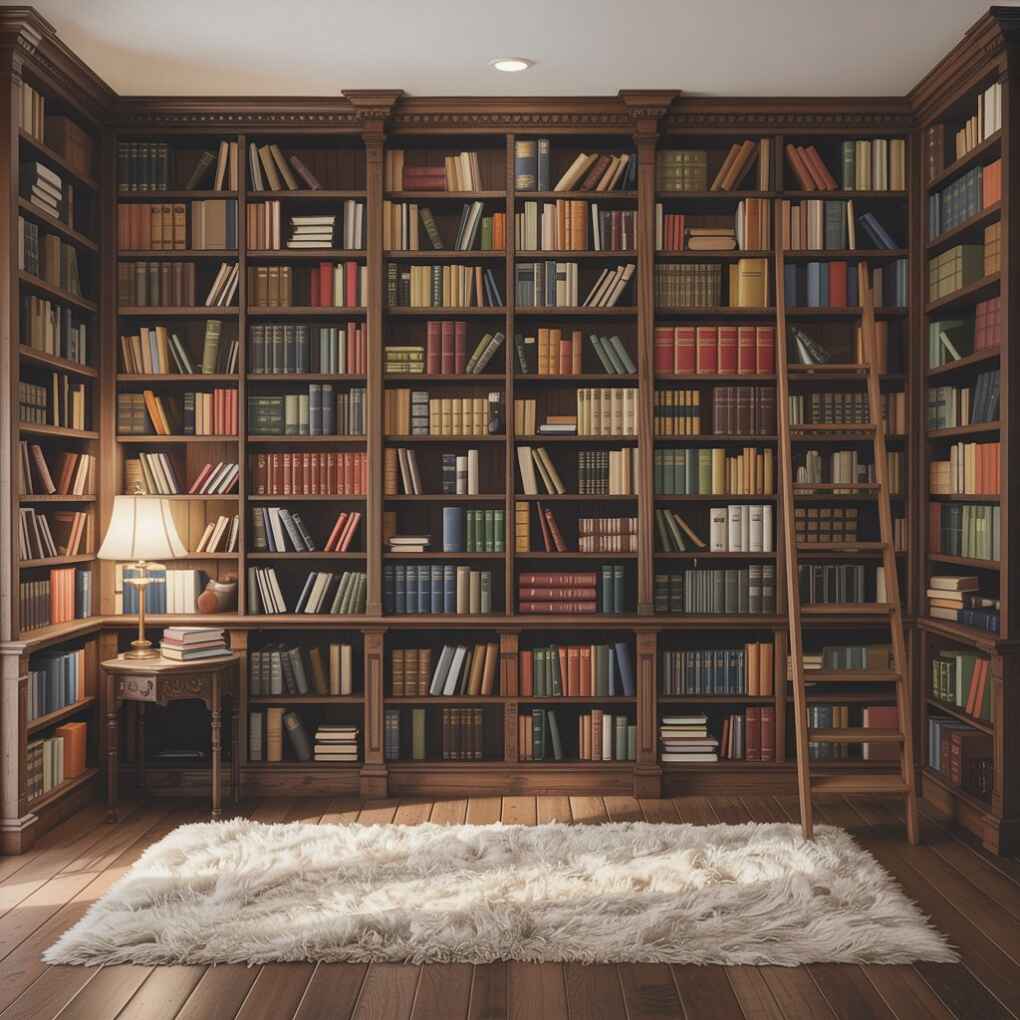
Pro Tip: Use a Pantone color wheel to plan your gradient transitions for professional-looking results—start with one dominant color family and create subtle shifts to adjacent hues.
3. Sustainable Material Showcases
2025 marks sustainability as the undeniable cornerstone of thoughtful home decor. Rather than hiding eco-conscious choices, designers now celebrate sustainable materials as central decorative elements. Feature reclaimed wood bookshelves alongside upcycled accessories, bamboo bookends, organic cotton book sleeves, and handmade ceramics crafted from recycled materials.
This trend goes beyond mere aesthetics—it represents a meaningful shift in homeowner consciousness. Sustainability isn’t just a buzzword anymore; it’s integrated into every design decision. When styling shelves, prioritize quality over quantity and choose pieces with authentic stories about their creation and materials. Display handwritten notes about each item’s origin to create personal connections with your decor.
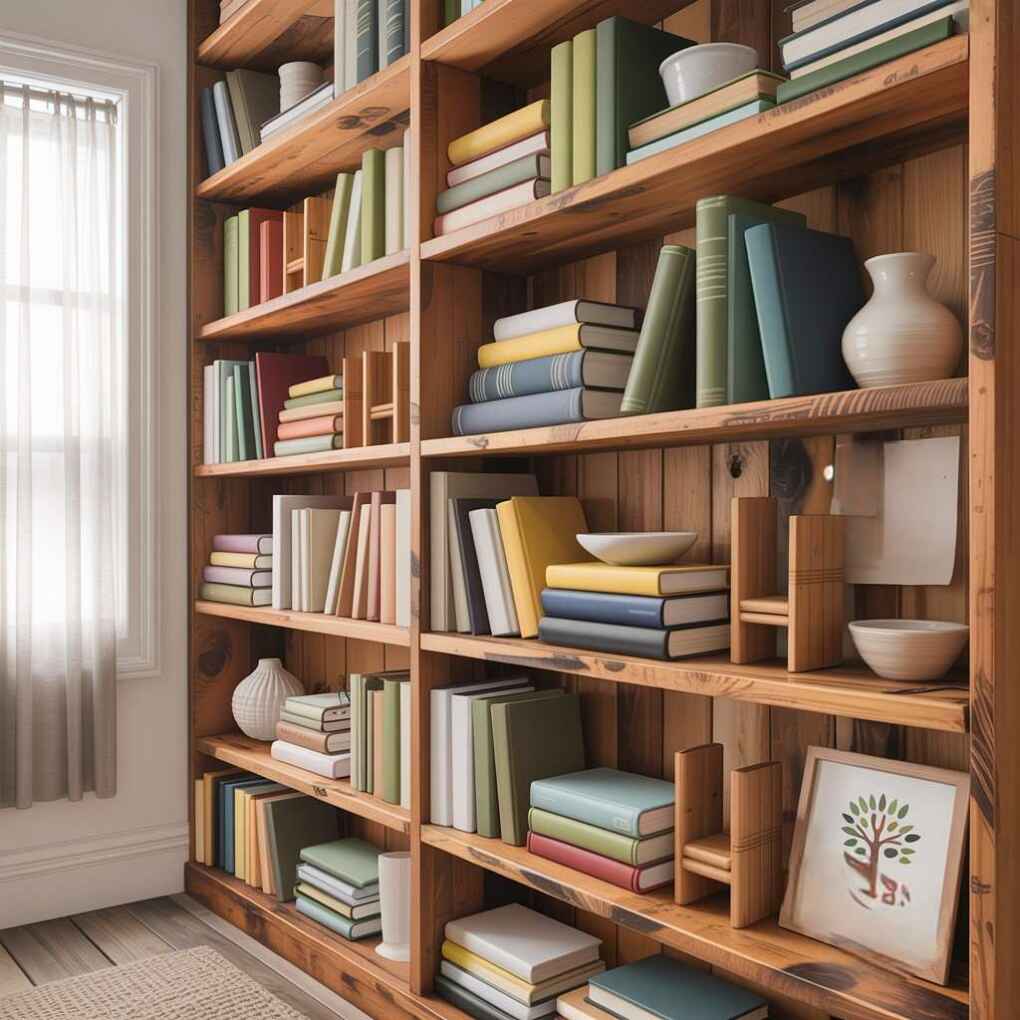
Pro Tip: Dedicate one shelf exclusively to sustainable storytelling—include small plaques explaining each item’s eco-friendly attributes and ethical production story.
| Material Type | Sustainability Benefit | Styling Application |
|---|---|---|
| Reclaimed wood | Reduces deforestation | Entire bookshelf construction |
| Recycled glass | Diverts waste from landfills | Decorative bookends or vases |
| Bamboo | Rapid renewable resource | Book trays or shelf dividers |
| Organic cotton | Chemical-free production | Book sleeves or storage bins |
4. Asymmetrical Balance Technique
Move beyond rigid symmetry that feels staged and impersonal. The 2025 approach to shelf styling embraces intentional asymmetry where visual weight balances across shelves without mirroring. Position a large ceramic vase on one side balanced by three smaller objects on the opposite side, or cluster books horizontally on one shelf while displaying vertically on another.
This technique creates dynamic energy that feels authentically lived-in rather than perfectly curated. As homemadebycarmona.com explains, shelves should express “your personality and personal style” rather than conforming to strict rules. Asymmetrical arrangements invite exploration and reward closer inspection, making your shelves more engaging conversation starters.
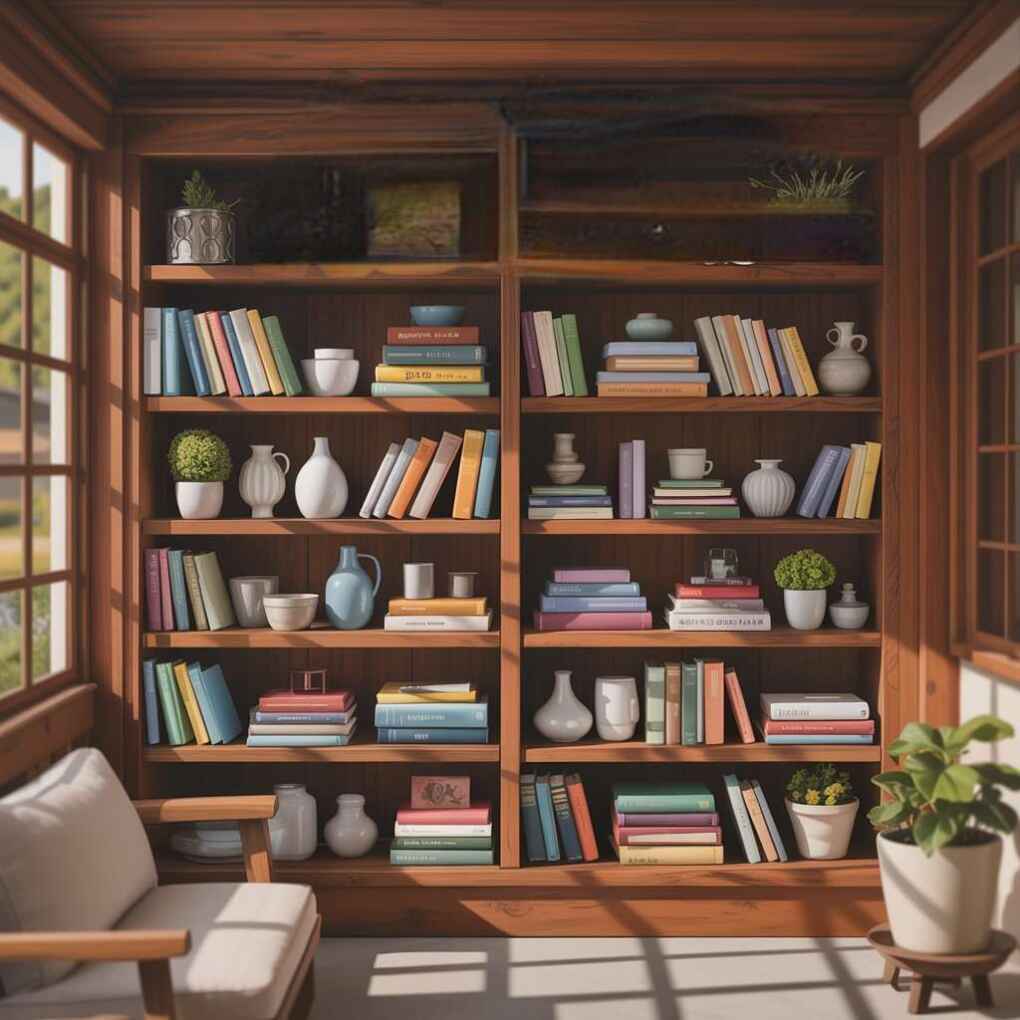
Pro Tip: Step back and photograph your arrangement—reviewing the image helps identify visual weight imbalances that might not be apparent during styling.
5. Integrated Art Gallery Shelving
Transform bookshelves into multi-dimensional art galleries that weave books and artwork together seamlessly. Instead of treating books and art as separate entities, display framed prints, photographs, or small sculptures among your books at varying depths. Create intentional negative space where artwork can breathe while maintaining visual connections to surrounding book collections.
This technique elevates books themselves as art objects while highlighting their cover designs and physical beauty. Rotate artwork seasonally or with your mood—swap out family photos for museum-quality prints when hosting guests. The key is ensuring cohesive scale relationships between all elements so nothing feels overpowering or undersized.
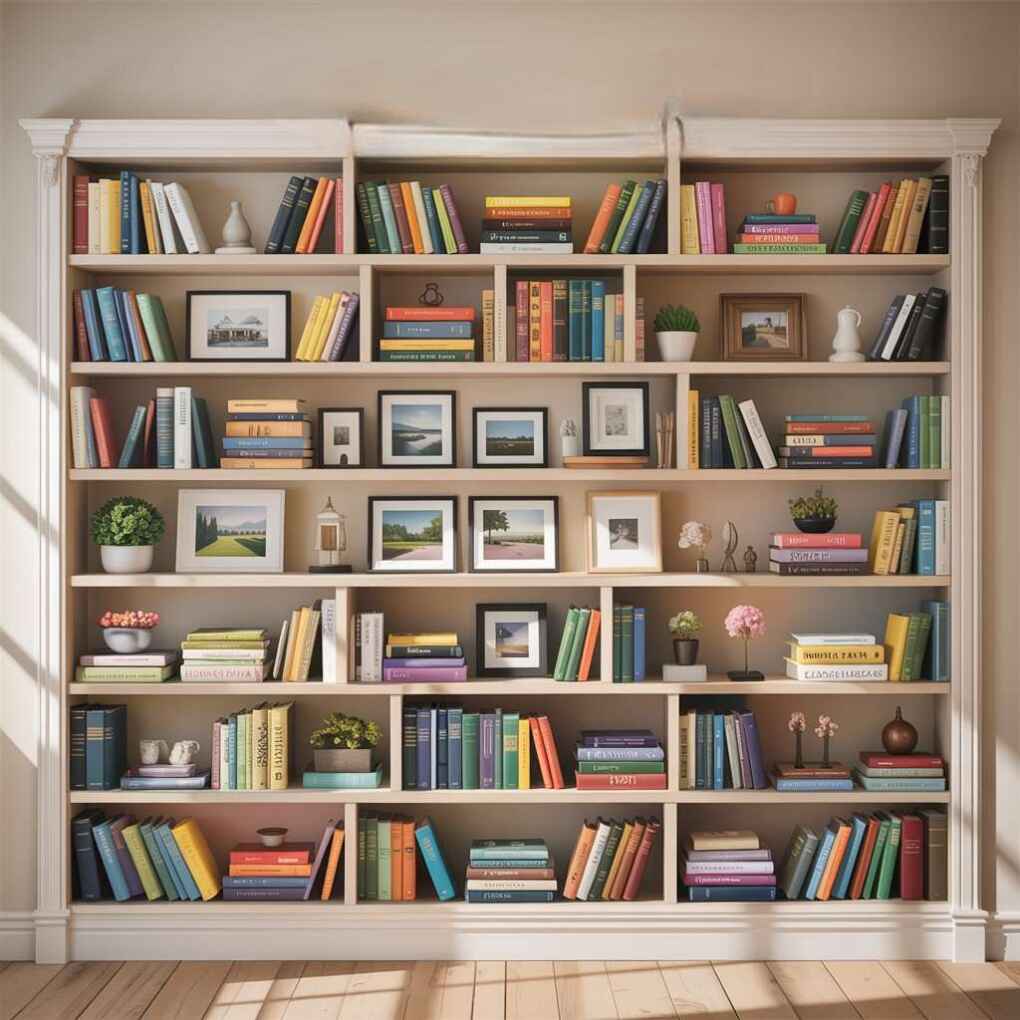
Quote: “Books and art aren’t competitors on shelves—they’re collaborators in storytelling,” shares interior stylist Mia Rodriguez of Brooklyn Design Collective.
6. Functional Dual-Purpose Shelving
2025’s practical elegance demands that beautiful spaces also serve meaningful purposes. Transform standard bookshelves into multi-functional installations that integrate charging stations, hidden storage compartments, or built-in lighting systems. Smart shelving units now conceal technology while showcasing aesthetic elements, with seamless cable management and discreet power outlets.
Modern homeowners prioritize spaces that support their lifestyles rather than dictate them. Rather than fighting against daily needs, incorporate charging docks for devices, hidden storage for remotes and controllers, and adjustable lighting that responds to different activities throughout the day.
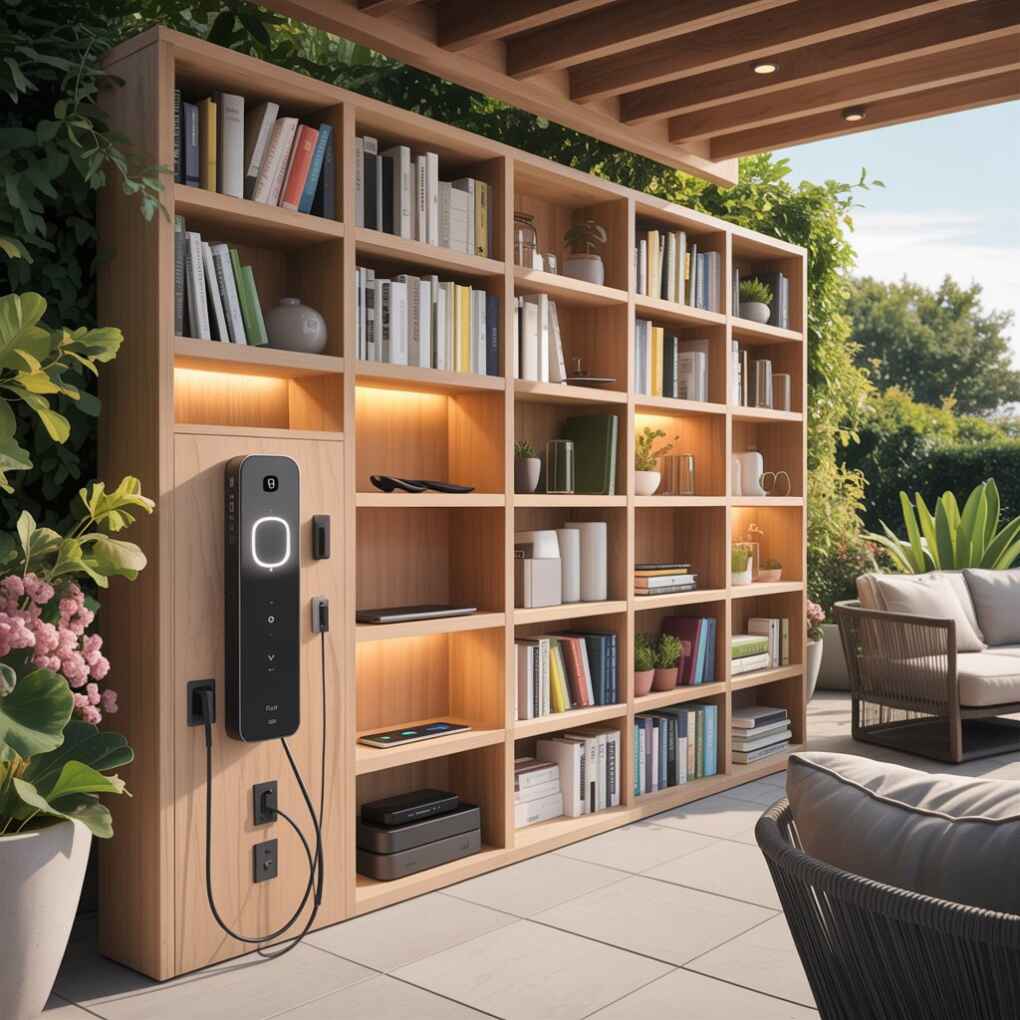
Pro Tip: Dedicate the bottom shelf exclusively for functional storage—use decorative baskets to hide everyday items while maintaining visual harmony.
7. Nature-Infused Organic Shelving
Bring the healing power of nature indoors through organic, biophilic bookshelf designs that incorporate natural textures and botanical elements. Layer shelves with preserved moss arrangements, dried botanical specimens, stone bookends, woven rattan baskets, and wooden sculptures that create tactile richness. These elements support the wellness-focused design movement gaining momentum throughout American homes.
Rather than artificial greenery, opt for dried flowers, seed pods, or interesting driftwood arrangements that require minimal maintenance while adding organic warmth. This approach aligns with weandthecolor.com‘s observation that “organic forms” represent one of 2025’s most significant interior design shifts.
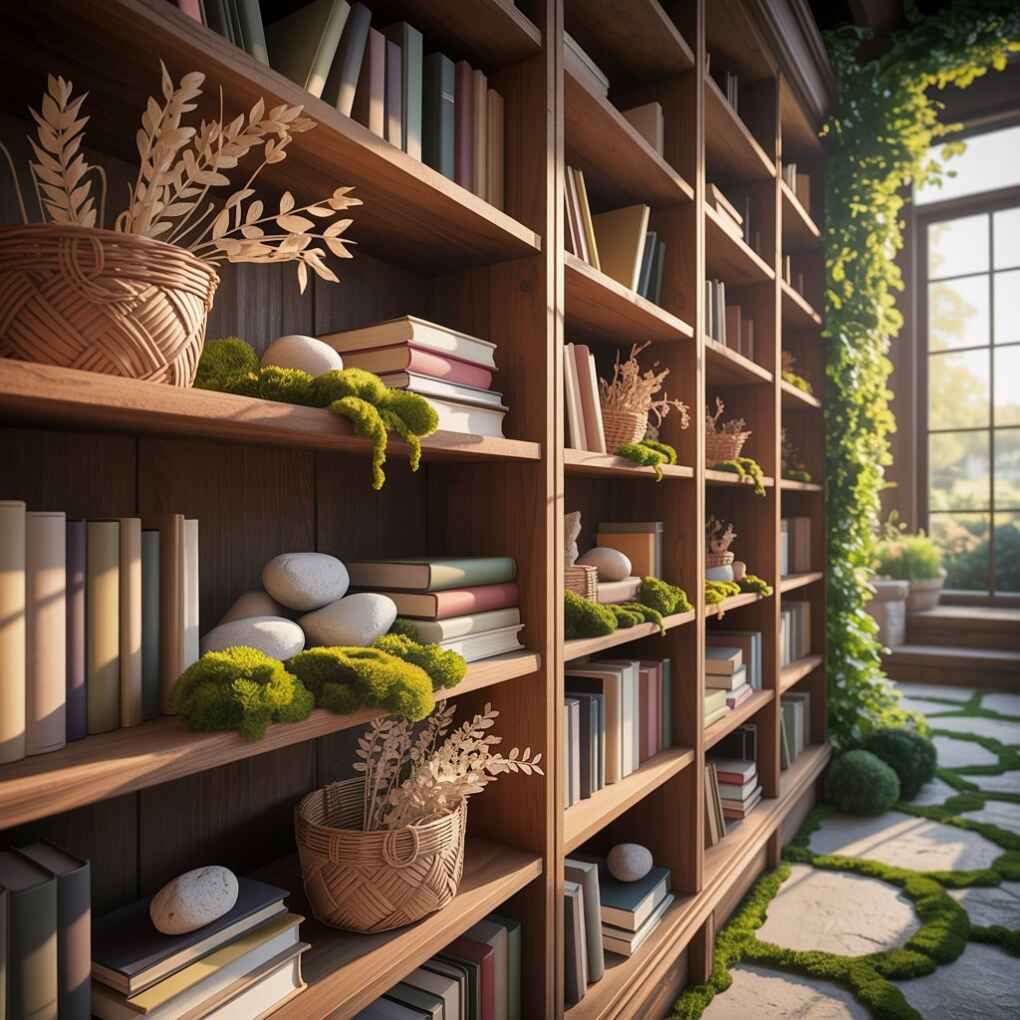
Pro Tip: Create miniature ecosystems on individual shelves using small terrariums or bonsai trees that become living centerpieces among your books.
8. Personal Artifact Galleries
Transform bookshelves into personal museums showcasing meaningful artifacts from your life journey. Intersperse books with travel souvenirs, family heirlooms, childhood treasures, and meaningful mementos that tell your unique story. This deeply personal approach creates shelves that genuinely reflect who you are rather than following generic design rules.
The key is thoughtful curation—display only items that spark genuine connection rather than filling space. Group related items together thematically: beach stones from coastal vacations with nautical books, vintage cameras with photography monographs, or family recipes with cookbooks. As homemadebycarmona.com reminds us, “styling shelves is not only a great way to bring a fresh new look to a room, it’s also a fun way to express yourself!”
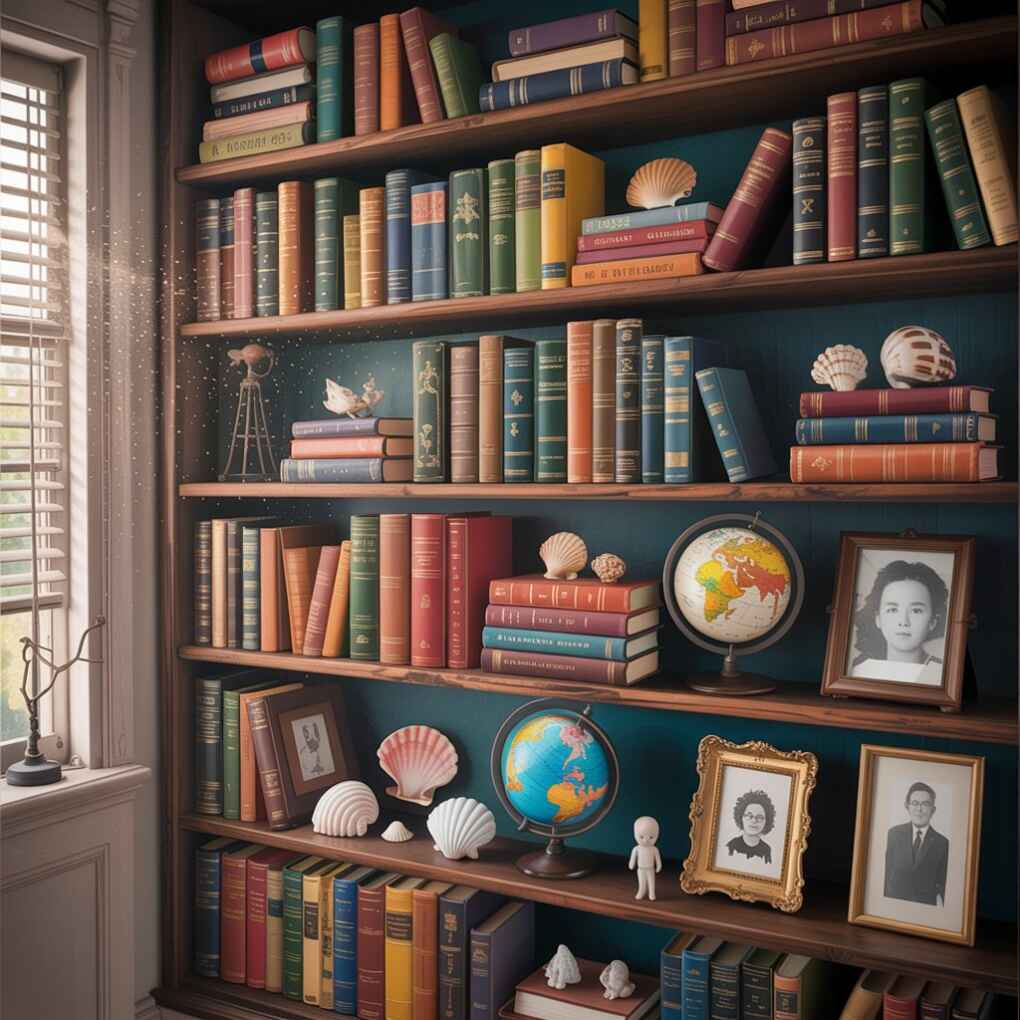
Pro Tip: Keep a “meaning meter” in mind—anything without genuine emotional connection should find a new home to maintain authentic curation.
9. Floating Shelf Illusions
Create magic through strategically placed floating shelves that appear to defy gravity while maximizing small-space functionality. Layer floating shelves at varying depths and heights to create dimension without overwhelming walls. This technique works particularly well in studio apartments or compact living areas where traditional bookshelves might feel bulky.
Choose slender metal or acrylic supports that visually disappear, allowing books and decor to take center stage. The most sophisticated implementations use precise spacing calculations to create rhythmic visual flow while maintaining practical storage capacity. For renters, use removable adhesive strips designed for heavier items to avoid wall damage.
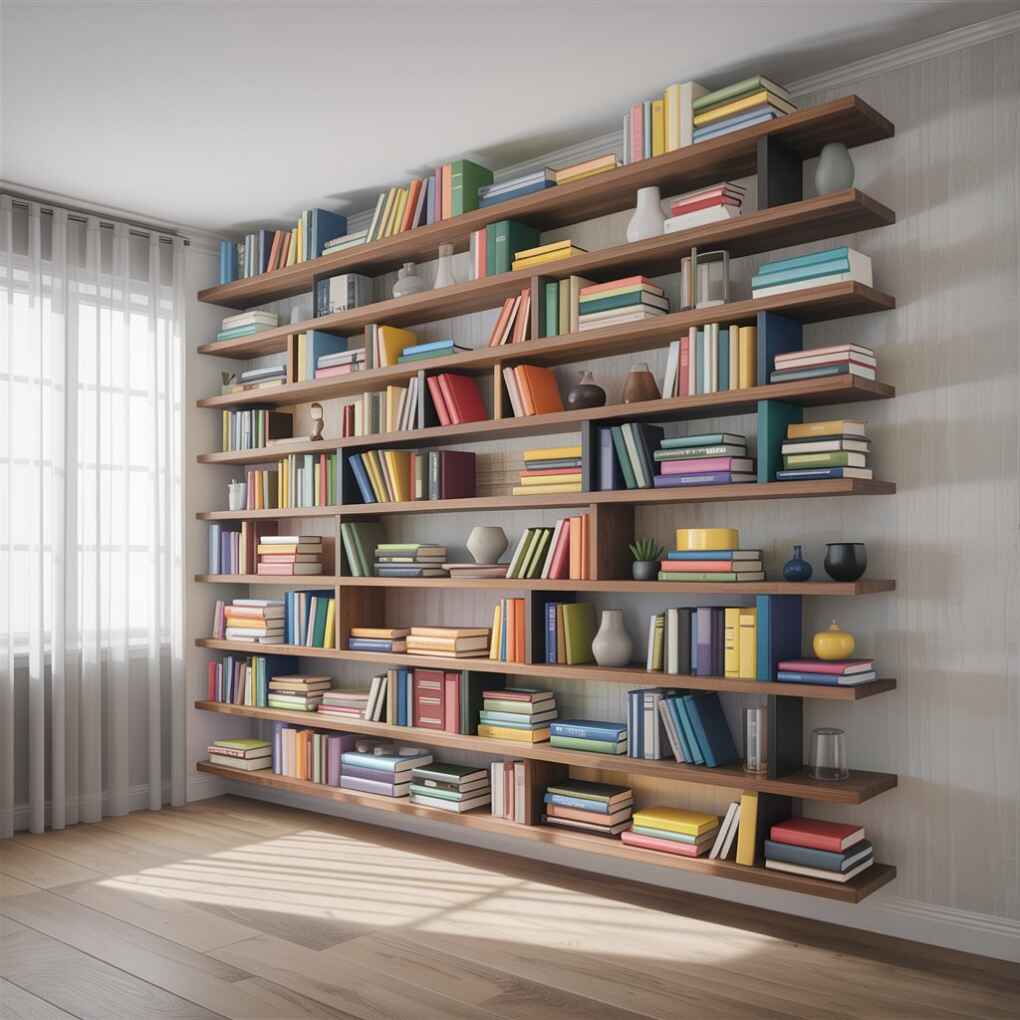
Pro Tip: Install floating shelves slightly higher than traditional eye-level to create the illusion of taller ceilings in small spaces.
10. Negative Space Minimalism
Counterbalance maximalist trends with intentional negative space that gives your eye room to rest. Instead of filling every inch, leave strategic gaps where shelves breathe and objects shine individually. This refined approach prevents visual clutter while highlighting your most treasured pieces.
The negative space minimalism trend represents a sophisticated evolution beyond basic minimalism—it’s not about having less, but about making what you keep matter more. Group items thoughtfully with breathing room between collections, allowing each piece to command attention without competing for focus.
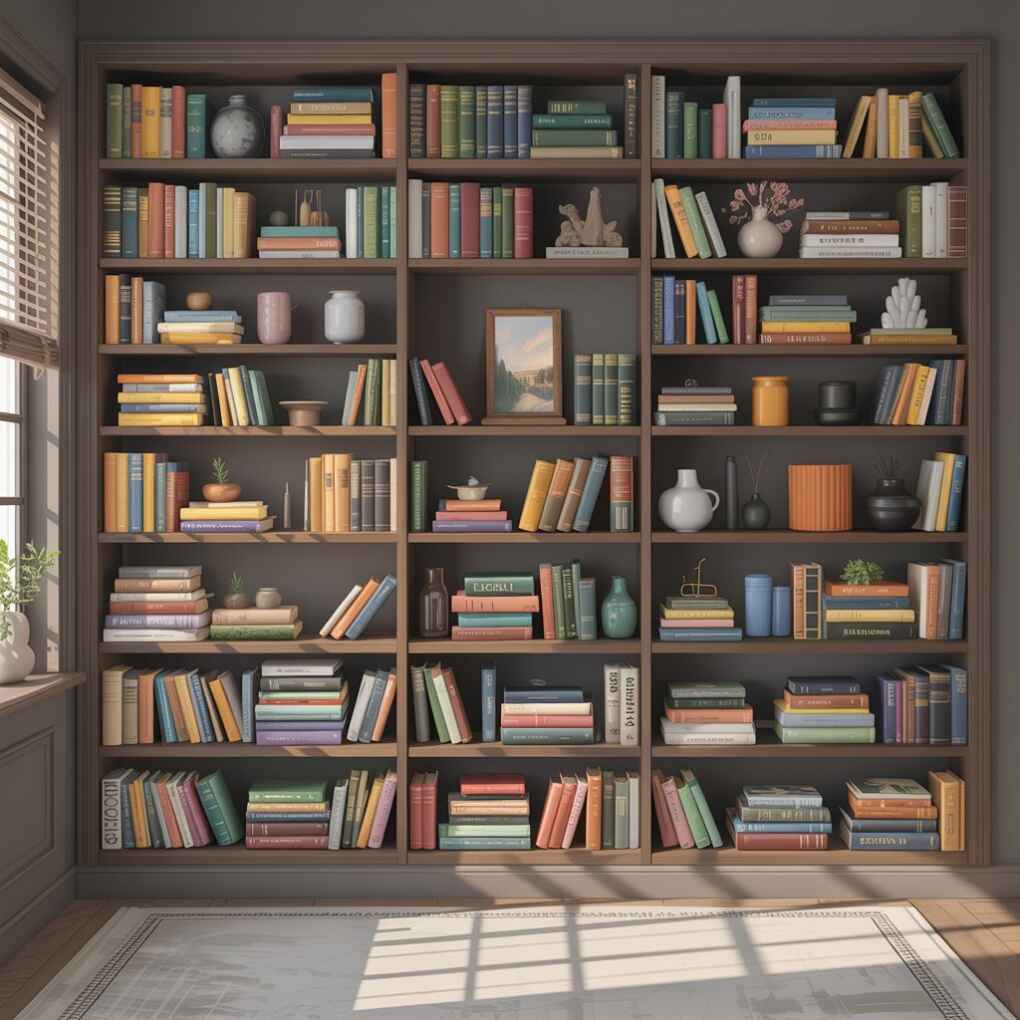
Pro Tip: Follow the 60-30-10 rule—60% books, 30% decor, 10% intentional empty space—for perfect visual balance on each shelf.
11. Multifunctional Room Divider Shelving
Double your square footage perception by using bookshelves as stylish room dividers that create distinct zones within open-concept spaces. Choose shelving units with intentional back panels or mirrored surfaces that enhance light distribution while defining separate areas for working, relaxing, and entertaining.
The most effective implementations consider sight lines from multiple angles—curate both sides of the unit thoughtfully since it will be viewed from all directions. For small-space living, opt for slim-profile shelving that maximizes function without overwhelming the area physically or visually.
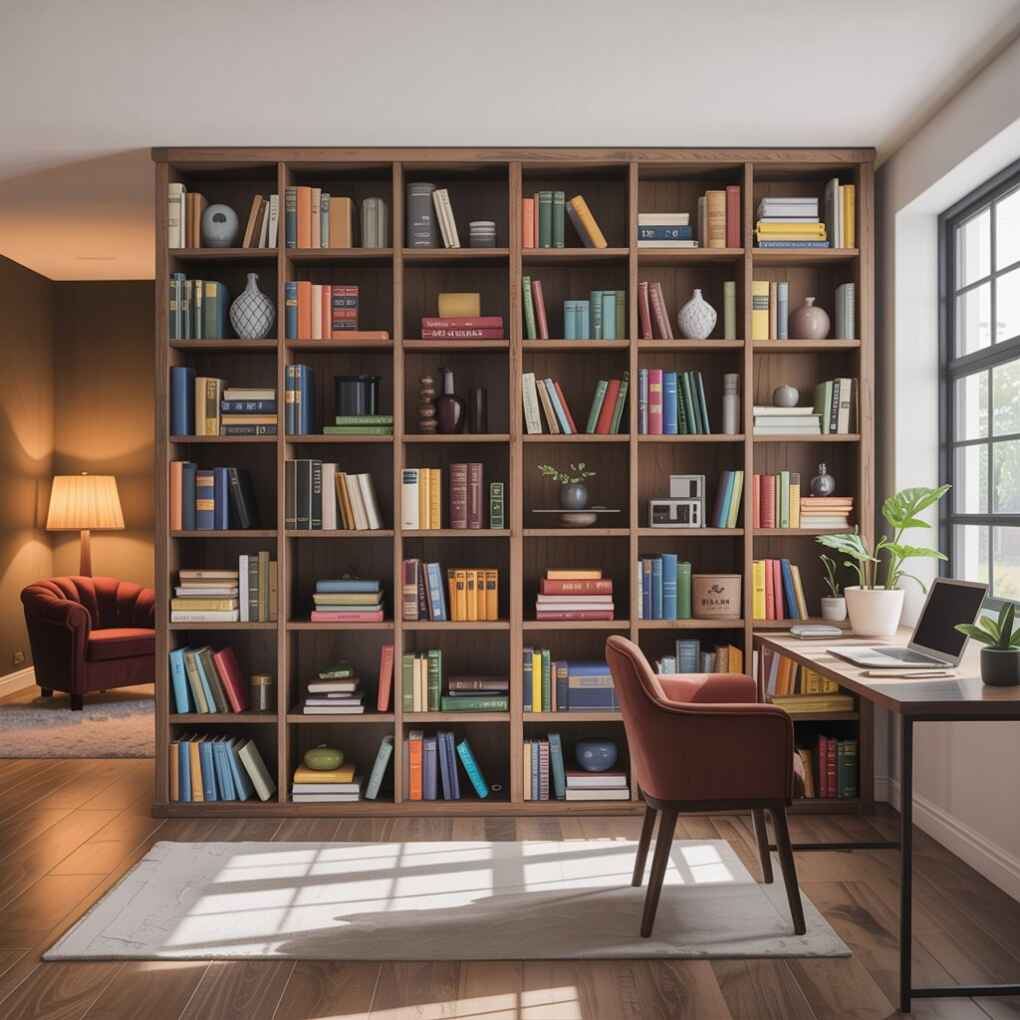
Pro Tip: Position room divider shelves perpendicular to windows to maximize natural light distribution throughout both separated spaces.
12. Thematic Collection Groupings
Create micro-exhibitions within your shelves by grouping items into cohesive thematic collections that tell specific stories. Dedicate entire sections to particular interests—vintage cookbooks with antique kitchen tools, travel literature accompanied by maps and souvenirs, or photography books displayed with vintage cameras.
These curated collections transform bookshelves from generic storage into personalized galleries that reflect your passions. Rotate themes seasonally or as your interests evolve—spring gardening books showcased with vintage seed packets, autumn reads accompanied by dried botanical specimens.
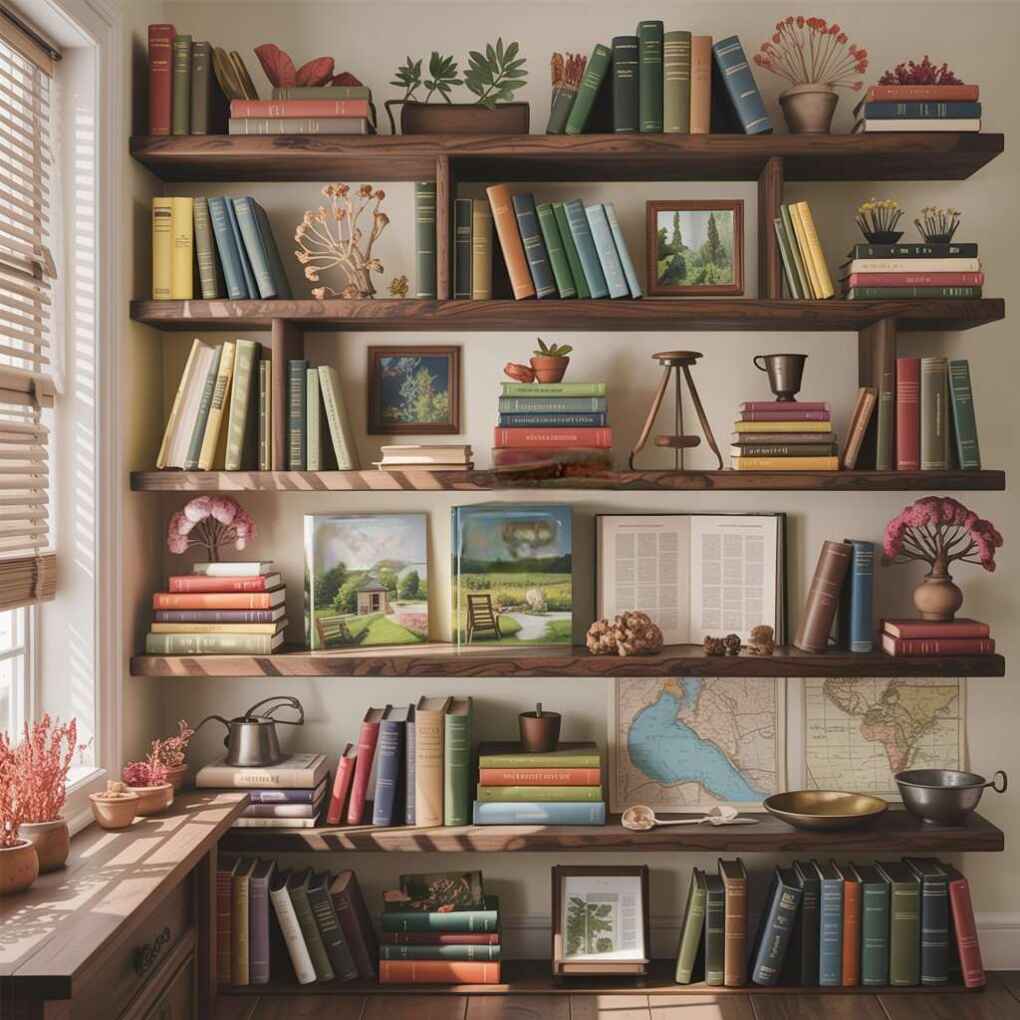
Pro Tip: Use consistent color palettes within each theme to create visual cohesion—for travel collections, stick with earthy tones; for culinary themes, embrace warm reds and yellows.
13. Integrated Illumination Systems
Illuminate your most treasured objects with sophisticated lighting solutions built directly into bookshelf structures. LED strip lighting along shelf edges, discreet puck lights highlighting specific collections, and adjustable track lighting systems transform ordinary shelves into gallery-worthy displays.
The most effective implementations combine ambient and task lighting—subtle background illumination creates warm glow while focused lights highlight specific objects. Smart lighting systems that adjust color temperature throughout the day complement natural light patterns, making shelves feel alive and responsive to their environment.
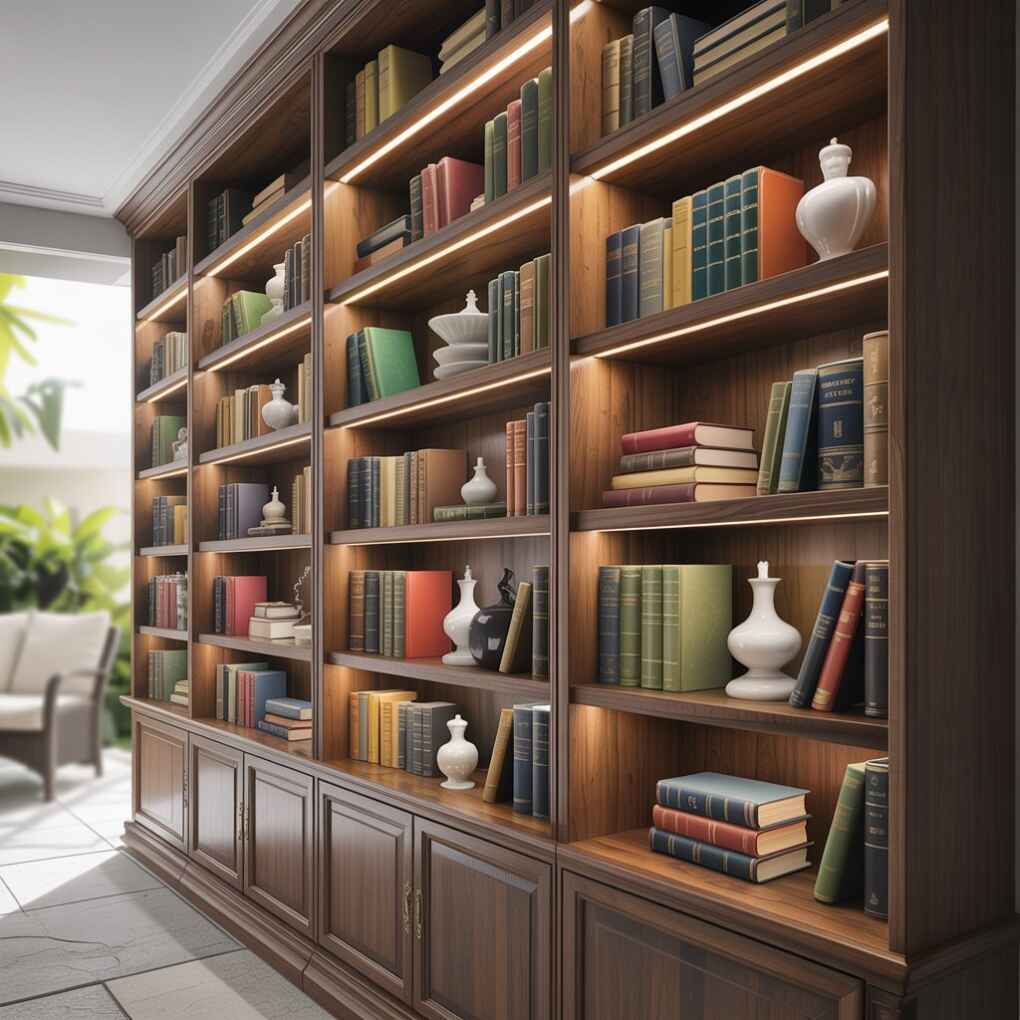
Pro Tip: Install dimmable lights on motion sensors so shelves glow softly when approached but conserve energy when unoccupied.
14. Textured Material Layering
Create rich tactile experiences through strategic layering of diverse materials that invite touch and exploration. Combine smooth ceramics with rough-hewn wood, sleek metals with woven textiles, cool stone with warm leather bindings. This sensory approach transforms visual displays into multi-dimensional experiences.
2025’s design ethos embraces authenticity and craftsmanship—showcase handmade pottery beside artisanal books, display hand-knotted rugs folded on lower shelves, incorporate textured wallpaper on shelf back panels. Each material tells a story of its creation and adds depth to your overall composition.
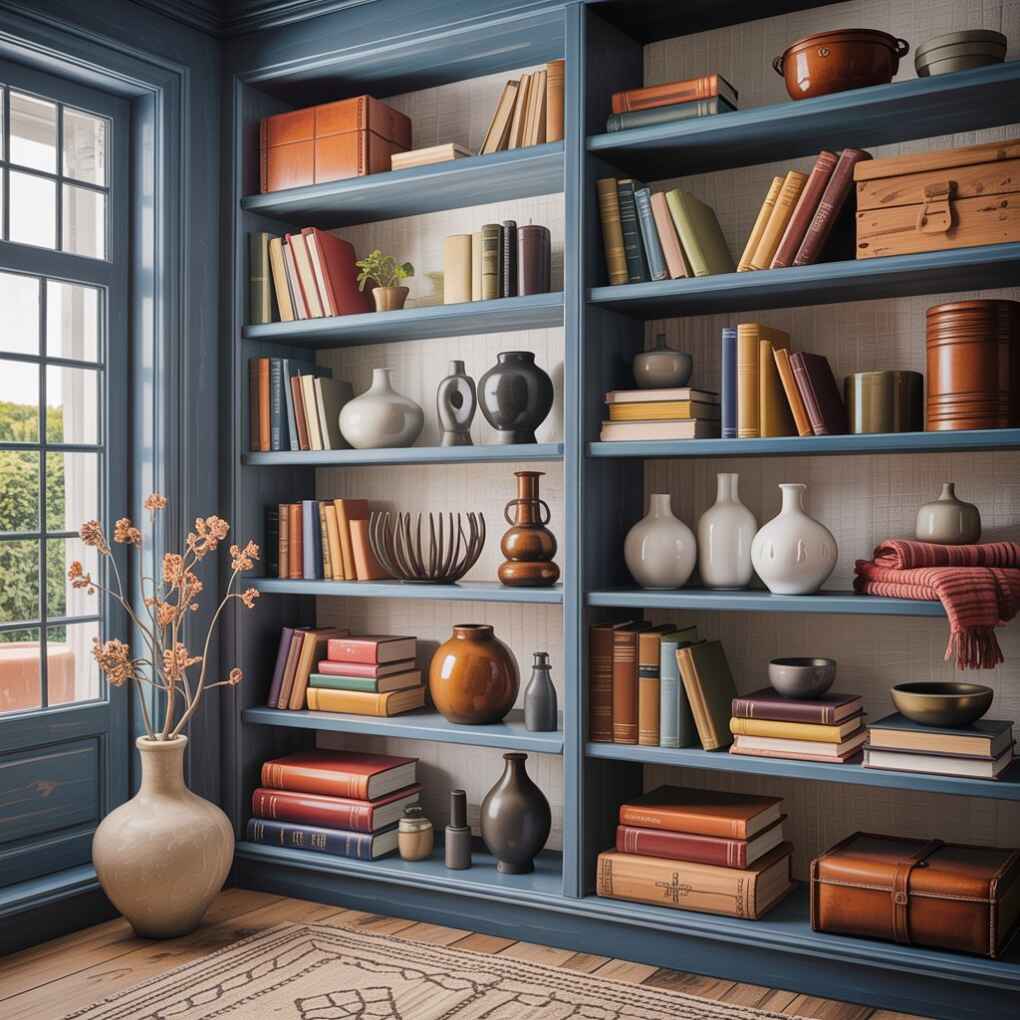
Pro Tip: Create a “texture ladder” moving from smooth to rough textures vertically—start with glossy objects on top shelves, progressing to more tactile elements below.
15. Tech-Integrated Smart Shelving
Welcome the future with bookshelves that seamlessly integrate smart technology while maintaining aesthetic integrity. Voice-controlled lighting systems, hidden charging stations, humidity-controlled compartments for delicate books, and even AI-powered recommendations for book placement based on visual analysis.
Modern smart shelving units respond to your lifestyle without compromising design integrity. Rather than visible wires and obvious tech elements, these systems integrate invisibly—touch-sensitive surfaces replace visible switches, charging pads hide beneath decorative trays, and environmental sensors maintain optimal conditions for valuable collections.
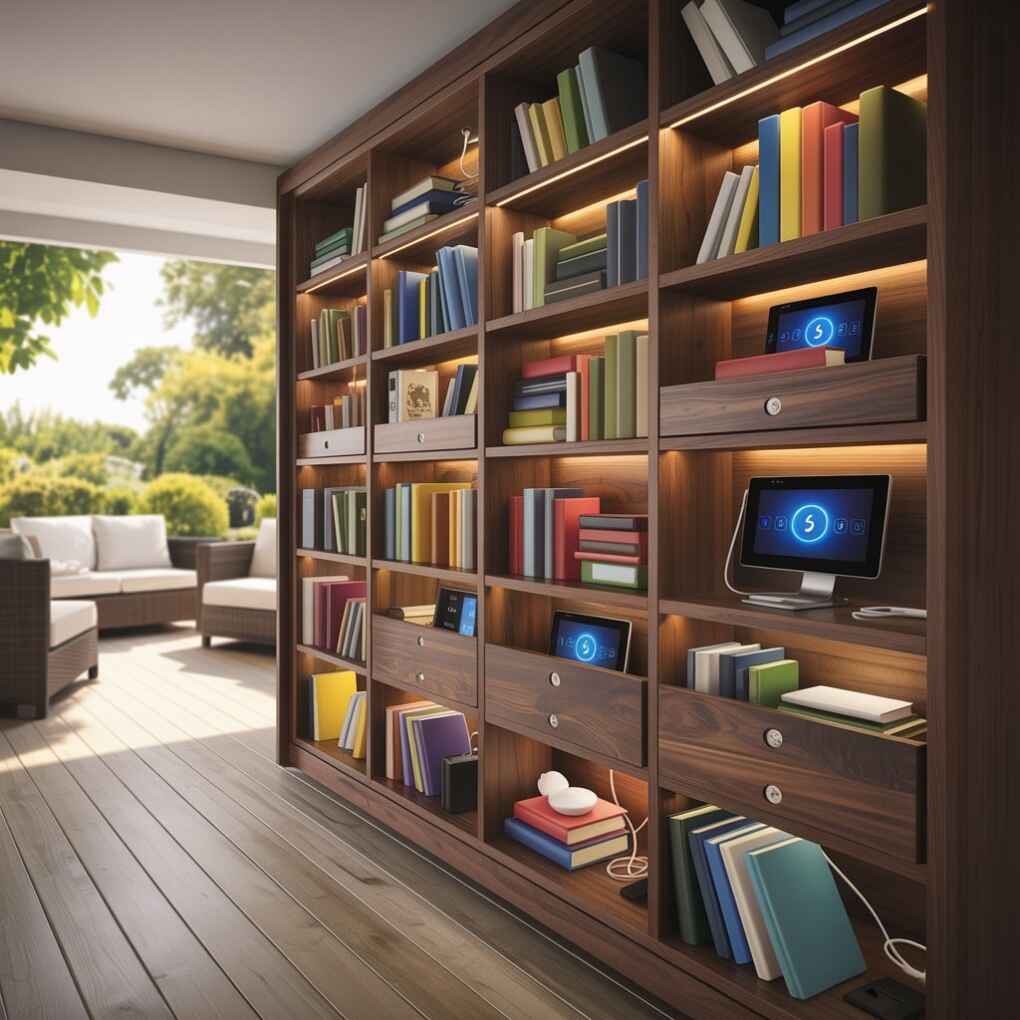
Pro Tip: Work with tech-savvy carpenters to design custom shelves with built-in cable management and concealed power access points for seamless technology integration.
Bringing Your 2025 Bookshelf Vision to Life
As we explore these fifteen transformative approaches to bookshelf styling for 2025, remember that your shelves should ultimately reflect your authentic self rather than rigid adherence to trends. The most successful designs balance current aesthetics with personal meaning—creating spaces that look beautiful while supporting your lifestyle and telling your unique story. When decorating shelves, begin with deliberate planning rather than random placement; livingcozy.com rightly emphasizes the importance of “having a game plan for how you’ll achieve the finished look.”
Create a mood board first, gather your favorite pieces, and experiment with arrangements before committing. Start with books as your foundation—then thoughtfully layer in complementary objects that enhance rather than overwhelm. Consider your space’s natural light, existing color palette, and how you genuinely use the area. The most stunning bookshelf designs serve as both functional storage and authentic personal expression.
Essential Bookshelf Styling Checklist
Before finalizing your design, ensure you’ve addressed these critical elements:
- Balance: Visual weight distributed evenly across shelves
- Breathing Room: Intentional negative space between objects
- Personal Connection: Every item has meaningful significance
- Lighting: Proper illumination highlighting key elements
- Functionality: Supports your lifestyle needs
By embracing these fifteen approaches while staying true to your personal aesthetic, you’ll transform ordinary bookshelves into extraordinary design statements that elevate your entire home environment throughout 2025 and beyond.
